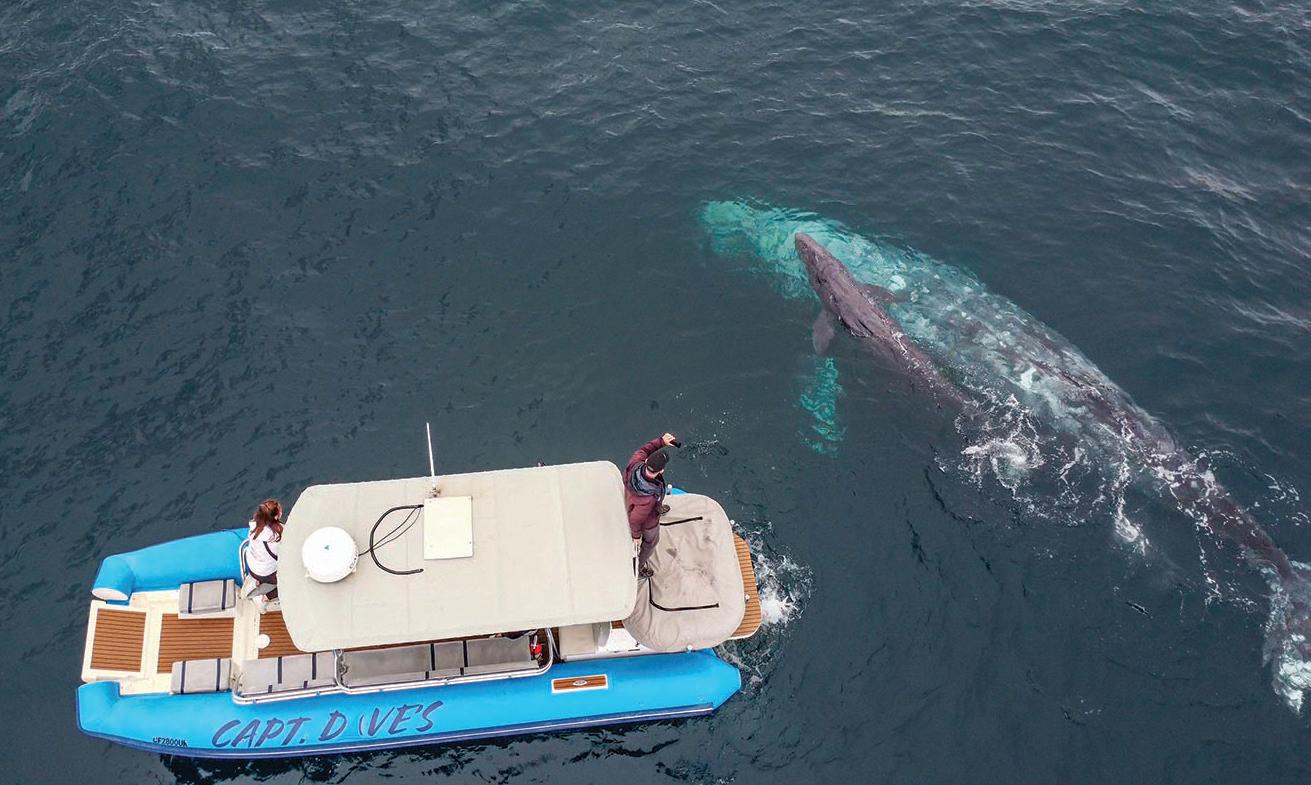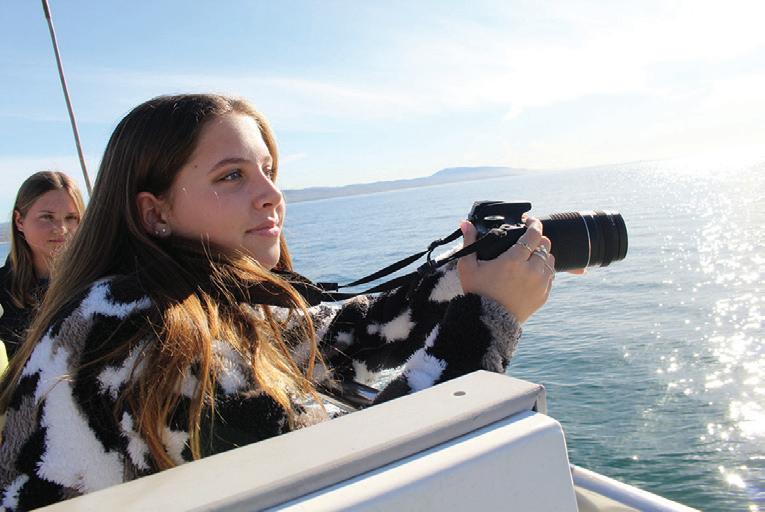
5 minute read
You Never Know What You Will See
BY CAPT. DAVE ANDERSON
I AM A BLESSED MAN WITH AN UNUSUAL OCCUPATION.
Advertisement
I, we, have seen a lot off the coast of Dana Point over the past 28 years. I have witnessed a pod of more than 10,000 common dolphins, so large it stretched out over five miles. I’ve watched pacific white-sided dolphins and bottlenose dolphins bow riding and frolicking in front of blue whales and humpbacks and gray whales and make themselves just as vulnerable in front of our boats.
In separate incidents, we had a bottlenose dolphin and a pilot whale pushing their dead calf around unable to let go, grieving. One day, I was surprised by a gray whale mom with twins, because they normally have only one calf.
I have filmed so many amazing things with my drone within a few miles of our harbor, such as dolphin stampedes or a blue whale calf nursing from her mother or a group of eight gray whales swimming together like dolphins.
I couldn’t believe my joy at seeing a humpback whale free itself from a prawn trap, just outside Dana Point Harbor, with violent thrashes and breeches twisting and turning because they have no hands or arms to untangle themselves.
I have seen countless balloons in the water, day after day. Balloons that should be illegal to release, like any other littering on land or in the ocean.
We’ve seen hundreds, maybe thousands, of gray whales pass by our whistle buoy, jetty and harbor entrance, a few mistakenly even coming inside our harbor. I have seen gray whales breach and reach for the sky, and I’ve seen them die, taking their last breath on the shore after being entangled for over a year.
I have been towed by a blue whale and then thought about him for days after he escaped our attempt to free him of 200 pounds of crab traps. I’ve seen way more failures than successes, as many here in Dana Point have answered their silent calls for help over the years. I’ve made my living from whales, and so I was willing when they needed my help.
One day, I had to make the call to leave and give up on the rescue of an entangled gray whale calf, because her mom wouldn’t let us get close enough to her offspring to remove the fishing gear. It was heartbreaking.
So, in January, when a gray whale actually gave birth in front of three of our whale-watching boats, I was moved to tears.
She could have easily moved away from us. Why would she give birth next to our whale-watching boats and then bring her weak, flopping progeny over to our boats, as she did that day? As if to say, “Hey, look at my beautiful calf,” as gray whales often do in the birthing grounds in Baja.
Why, when our own dogs wouldn’t even do that and might not even let you near their pups? Why did she trust us? Why do they trust us when we hunted them almost to extinction and fill the ocean with plastic and accidentally catch them in fishing gear or run them over?
We have the first and longest-running Festival of the Whales. And it is fitting. We should have a festival; we should celebrate the gray whale migration. We should celebrate all their courage—to not run away, far away from us.
And, instead, let us carefully watch them. And even trust us with their newborn. We can do better with what has been given to us to care for and protect. And we will.
Instead of taking a test or turning in homework, Dana Hills High School student Maddie Keene spent part of her school morning out on the water.
Keene, 16, was onboard a Dana Wharf Sportfishing & Whale Watching boat on Thursday, Feb. 2, for a class trip visual arts students took in conjunction with the upcoming Festival of Whales.

The boat ride out of Dana Point Harbor is an annual tradition intended to foster ecological curiosity in students and so they can explore different environments in their own backyard.
Some students, including Keene, took photos of the water and sea lions they saw for a class project. Other students will draw what they witnessed or artistically convey the trip in other ways.
“I think it’s really cool that our school is able to experience these types of things, especially because we live in this area,” Keene said. “I’m really grateful that we get to have this experience when there are a lot of other kids who don’t get to see the ocean in their lifetime. I just always feel super grateful.”
Keene has gone on previous whale watching excursions, but Thursday’s outing was her first time with classmates. She has previously participated in the Festival of Whales, which will happen at around the Dana Point Harbor this year from March 3-5.
“Last year, what we did is we took whales and made a logo for the Festival of Whales,” Keene said.
This school year marks the first time Keene is studying photography, though she has taken other art classes in the past.
“Being able to take pictures of the cool stuff of the area that we live in,” Keene said of what she likes about photography. “Dana Point is a very photographic area to live in.”
Visual arts instructors Jon Ginnaty, Chau Tran and Natalie Hribar-Kelly accompanied their students on the trip. Ginnaty—who teaches ceramics—said his students might translate their trip into ceramic work if possible but, if not, will still appreciate the life experience of going out in the Pacific Ocean.
“Festival of Whales will have a booth that displays some of our student artwork,” Ginnaty said. “We’re gaining inspiration to turn around and make objects we’ll present at the booth.”
Getting outside the classroom is a wonderful experience for the kids, he said.
“A lot of these kids might not have the resources to go on a boat like this,” Ginnaty said. “To offer this opportunity is once in a lifetime for some of these kids. To just take a break from the classroom and be out in the sun and out in the nature, what you see and learn out here is more important than what you can pick up in one day in class.”
Nona Reimer, an educational consultant for Dana Wharf, said the trip can be a starting point for students to get motivated about helping conserve the ocean environment for whales and other marine life.
“That’s how it started for me. I was a marine ecology student at San Clemente High School,” Reimer said. “I was coming out on this boat, learning about gray whales, and here I am 50-some years later still concerned about these whales.”
Talking to students and seeing their love of art come together with concern for the whales is exciting, Reimer said.
“Putting that together is going to be an amazing door opening for their future,” she said. “It’s so important to have this partnership where we can bring these kids out here.”
Reimer also addressed the legacy of the Festival of Whales for the community.
“It goes back 52 years now,” Reimer said. “Our company, Dana Wharf, was instrumental in the founding of that program because it was so important to educate the community about these amazing gray whales that were migrating up and down the coast.”
“Going back 52 years is just about when the ecotourism business began of bringing the public out to see the whales,” she added.
For those interested in booking a whale watching trip of their own, please visit festivalofwhales.com.








